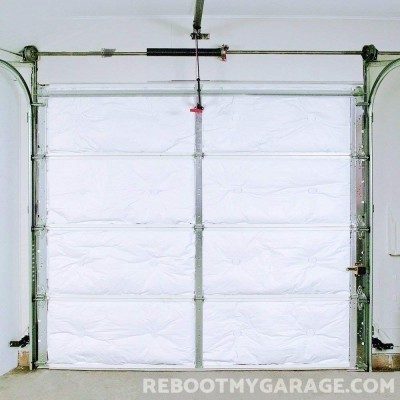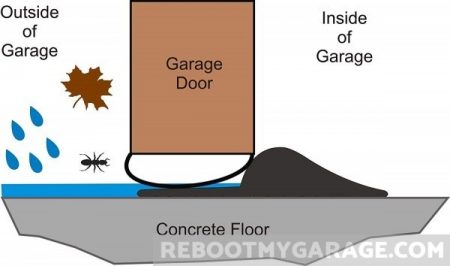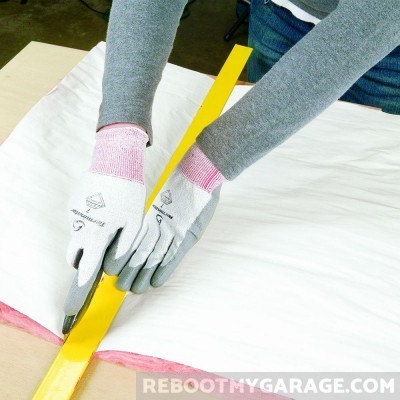Is Insulating Your Garage Door a Smart Move?
Is your garage a furnace in the summer and an icebox in the winter? You’re not alone. Your garage door is often the biggest culprit when it comes to extreme temperatures.
Insulating your garage door can be a great investment, but it’s not a magic bullet. Before you spend time or money, it’s smart to weigh the costs and benefits for your specific situation.
Plenty of affordable insulation options are out there. But to know if insulating the door is the right first step, you need to look at your entire garage—including the walls, windows, and ceiling.
Before you begin, here are our top-rated product recommendations. These will open in new browser windows for your convenience.
Set Realistic Expectations for Your Garage’s Comfort
The good news is that insulating your garage door is a relatively easy and cost-effective way to make your garage more comfortable. It can certainly help take the edge off extreme temperatures.
The bad news, however, is that it won’t instantly make your garage feel like another room in your house. Even modest improvements depend on several other factors working together.
As we’ll discuss, if you have major air gaps or other uninsulated areas like walls or a ceiling, your efforts on the door alone will have a very limited effect. Your garage will become a bit more habitable, but don’t expect miracles.
In the end, it’s up to you to decide whether spending $60 on a space heater will go further than using the same money on door insulation. Taking a moment to clarify your goals goes a long way.
What Is R-Value and How Does It Affect Your Garage?

R-Value is the number you can use to compare the insulating effects of various products. The higher the number, the more insulating power it has.
Sounds simple, right? It is, but there is more to the story. R-Values are calculated in a lab under ideal conditions.
According to the U.S. Department of Energy, an insulation’s R-value is its measure of resistance to heat flow. Your garage door, walls, and home are far from ideal.
For example, a wall has wooden studs between the insulation. If the insulation has an R-Value of R13, the studs themselves only have an R-Value of around R6.
The entire wall has a combined R-Value based on a formula that includes all its parts. Add in windows, small gaps, and unsealed seams, and you can see how the real-world number is different.
Even then, average temperature and comfort aren’t the same. We’ve all felt a cold draft even when the house is otherwise comfortable. Remember, concrete garage floors can be cold even when the garage door is insulated.
How Does Heat Move In and Out of Your Garage?
Heat moves into and out of your garage in three primary ways, as explained by scientific resources like Thermopedia.
First is Radiation. This is when the sun beats down on your garage door, transferring heat energy through the air.
Second is Convection. This is the movement of warm air upward and cool air downward. Heat rises into the garage attic, and this creates a current that pulls cool air in from outside through gaps.
Third is Conduction. This is a molecular heat transfer that happens when objects touch. The sun heats the door through radiation, and that warmth is transferred to the air inside your garage through conduction.
R-Value only measures a material’s resistance to conduction under perfect lab conditions. The bottom line? Real-world factors like wind and moisture can make your insulation less effective than its R-Value suggests.
Find and Fix Your Garage’s Weakest Links First

Before you insulate the door, it’s time to play detective. Air will get in through any openings, seams, and gaps. Stopping this infiltration is your true first line of defense.
You can spend hours perfectly insulating the door, but a single large gap elsewhere will make your work pointless. Before buying insulation, check your doors and windows for gaps.
If air is whistling through these gaps, you must fix this problem first. Then ask yourself: Are my garage walls insulated? If they are, insulating the garage door is a logical next step.
If your walls are not insulated, you’re at a decision point. Uninsulated walls transfer a massive amount of heat. An insulated door will help, but not enough to justify the cost if the walls are bare.
If you decide to insulate your walls, you can use fiberglass, rock wool, or blown-in cellulose. As Home Depot’s experts advise, a total-garage approach is best.
Don’t forget the ceiling. If your garage has an attic, remember that heat rises. Insulating the ceiling is a tougher job, but it’s essential for stopping heat from escaping upwards.
Finally, check your garage windows. They are a huge source of heat loss. A simple plastic sheet kit, like this one on Amazon, can make a big difference.
How to Pinpoint Problems with a Thermal Leak Detector

Finding the source of the problem is the first step to fixing it. Unless you can see daylight through a hole, you might not spot the areas you need to fix.
The U.S. Department of Energy provides guidance on sniffing out these problem areas, and the easiest way is with a tool.
Use a thermal leak detector to find hot or cold spots throughout the garage. The results will tell you exactly where you need to insulate or seal to get the temperature under control.
We recommend the Black and Decker TLD100 Thermal Leak Detector. This useful device lets you measure temperatures and spot differences on surfaces.
Is the electrical outlet colder than the rest of the wall? Is the door colder than the wall next to it? A thermal detector removes the guesswork and helps you decide where to focus your attention.
First, Seal Gaps with Weather Stripping

Old or damaged weather stripping around the garage door is a prime culprit for air leaks. Door manufacturers like Clopay emphasize that replacing it is a critical first step.
Use vinyl or foam weather stripping to seal gaps on the door’s top and side edges. Install the side seals first, then let the top seal drape over them to ensure water runs off correctly.
p>Next, seal the bottom of the garage door. If your door has a channel, you can get a kit like this DGSL Seal to slide a new rubber seal through it.
A helpful tip for installing a channel seal is to soak the new rubber in a bit of soapy water. This will make it slide into the channel much more easily.
An easier option is a seal that sits on the garage floor, which you press the door down onto. My article The Best Garage Door Seal details how to install this type of universal seal.
Another option for doors without channels is replacing the strip nailed to the bottom of the door. You can use a product like the Universal Aluminum and Rubber Garage Door Bottom seal.
If your door is made by a major brand like Clopay, Amarr, or Raynor, you should get this specific seal from Amazon, designed to fit those doors perfectly.
A Common Mistake: Sealing Between Garage Door Panels
The most common type of garage door is the sectional door. When it opens, the door breaks into sections that roll along a track. The gaps between these hinged sections are another opportunity for air to get in.
With the door closed, go inside and check for light coming through where the sections meet. This will show you where the gaps are.
Caution! Do not weather strip garage door sections that aren’t letting in light. Adding weather stripping where it’s not needed can add stress to the hinges and damage the door.
This can potentially cause the door to become unbalanced, which is a serious safety and performance issue.
If you do see gaps, use foam weather stripping with an adhesive back to seal them. You’ll need a ladder and a friend to help.
Work one section at a time, locking the door in place. Carefully stick the weather stripping tape to the top edge of the lower section in the gap.
After you’re done, check your work. On a sunny day, close the garage door, turn off the lights, and let your eyes adjust. Look for any remaining slivers of light peeking through the cracks.
What Are the Best Insulation Materials for a Garage Door?
There are three basic types of insulation for garage doors. The one you choose will depend on your door type, climate, and budget.
- Batt insulation is the thick, fluffy fiberglass or rock wool material that comes in rolls. It works best when it has room to expand; compressing it ruins its effectiveness. This Owens Corning kit on Amazon is a great choice for metal doors with channels.
- Foam board insulation is a stiff, rigid panel that resembles Styrofoam. It has a lower R-value but is versatile. CRITICAL: Only use foil-faced rigid panels, as unfaced polystyrene is a fire hazard, as noted in this guide to rigid foam.
- Reflective insulation is a flexible material surrounded by shiny foil. It excels at reflecting radiant heat and keeping garages cooler in hot, sunny climates. If summer heat is your main enemy, check out this reflective insulation option on Amazon.
For most DIYers, buying a full garage door insulation kit is the best bet. Kits come with the correct insulation panels and all the proper fasteners you’ll need.
The main complaint about kits is that the adhesive sometimes fails. To prevent this, thoroughly clean the door surface before applying the fasteners. It’s also best to install it on a mild day when the door isn’t extremely hot or cold.
Why You Must Rebalance Your Door After Adding Insulation
Your garage door has powerful springs that are precisely adjusted to its weight. These springs make the heavy door feel light and easy to open.
A properly balanced door should stay put when you stop it halfway open. It should not shoot up or fall down on its own.
Even the small amount of weight added by insulation can throw this delicate balance off. An unbalanced door can cause major problems.
If the door is off balance, it may not seal correctly at the bottom, letting in outside air and undoing your hard work.
More importantly, it puts incredible strain on your motorized garage door opener. The motor is designed for a balanced door; forcing it to lift extra weight will wear it out quickly.
WARNING: Garage door springs are under extreme tension and are very dangerous. Garage service professionals strongly recommend against DIY adjustments.
If your door is unbalanced after you insulate it, please hire a professional to rebalance the springs. It’s a small cost for a huge piece of mind and safety.
Is Your Garage Stealing Your Home’s Heat and A/C?
An uninsulated garage attached to your home acts like a giant heat sink. If your garage is significantly cooler in winter or warmer in summer than the outside, your house is likely losing energy to it.
If your primary goal is to save on energy bills, the most important place to insulate is the wall that your house shares with the garage. This will stop the energy bleed.
When insulating this shared wall, install the insulation “backward.” This means the paper/foil vapor barrier should face the house (the conditioned space), and the fuzzy side should face the garage.
The same rule applies to any living area above the garage; the paper vapor barrier should always face the conditioned living environment.
Also, pay attention to the entry door from the garage to the house. Builders often use a cheap, uninsulated door here. Add weather stripping and consider upgrading to an insulated door.
Finally, use your thermal leak detector on electrical outlets and any openings for pipes or wires. You can buy “socket sealers” or “pipe insulation tubing” to close these small but significant gaps.
The Unexpected Perks of an Insulated Garage Door

Beyond temperature control, insulating your garage door offers several hidden benefits. For one, it significantly helps to reduce noise coming in from the outside.
It also helps reduce the noise your neighbors hear coming from your garage. This is a huge plus if you use your garage as a workshop.
Sealing and insulating the garage also helps prevent fumes and dust from getting into your house. Garages are often dirty environments, with car emissions and stored chemicals.
An untreated concrete floor constantly generates fine dust. Bugs and pests can easily enter through the large door opening.
When you take the steps mentioned in this article to seal and insulate, you are also improving your home’s air quality and security.
Garage door insulation, by itself, is a small but important step in protecting your house from noise, fumes, dust, bugs, and intruders.
Garage Door Insulation Types

- Measuring the Owens Corning garage door insulation batting
There are three basic types of insulation for garage doors:
- Batt insulation is the thick, fluffy fiberglass or rock wool that comes in rolls. Rock wool is more expensive but has much better fire retarding properties than fiberglass. The thick and fluffy nature of batt insulation is what makes this insulation work. If your garage door can accept batt insulation great, if you have to compress it, then don’t use batt insulation. Compressed batt insulation doesn’t work. Here is a great choice for batt insulation on Amazon. It’s an Owens Corning garage door insulation kit.
- Foam board insulation is a stiff, rigid panel that resembles Styrofoam. It has a lower R-value than batt insulation.It can be used on wooden and metal doors. Only use foil-faced rigid panels. Unfaced polystyrene is a fire hazard.
- Reflective insulation is a flexible insulating material surrounded by shiny foil. It helps keep garages cool in the summer.It can be combined with other insulation types. If your main concern is keeping your garage cool, check out this reflective insulation option on Amazon.
Garage Door Side Channels
The other thing to keep in mind is that for the most part manufacturers assume you have a metal door with channels on either side where you can insert the insulation.
If you have a wooden door you will need to use some form of tape or adhesive to secure the insulation.
These channels are a perfect fit for the fiberglass sheets in the Owens Corning garage door insulation kits like these from Amazon.
You can also fit the solid foam core insulation into them. Some wooden doors have recessed panels that can fit the foam core insulation found in rigid foam garage door insulation kits.
You will need to measure and cut the foam core to size.
You can then add another panel on top of that across the whole section.
For wooden doors, you should consider using the IMP SmartGARAGE Reflective Garage Door Insulation Kit (linked to here at Amazon).
This kit does not require a metal door like the others and is very thin and light.
You can use it in conjunction with rigid foam panels if you like. If you are buying a newer house, ask if the garage door is insulated.
Many of the newer garage doors have an insulating foam core already.
Rigid Foam Panel Insulation Caution!
An important note about rigid foam panels.
You absolutely must make sure that they are fire rated and have either a foil or vinyl facing.
Foam board by itself is extremely flammable.
That is another good case for buying a garage door insulation kit.
You may want to check your local building codes and your home-owners policy just to triple check.
Under no circumstances should you just buy random foam panels and use that as insulation.
Use Radiant Insulation for Heat Reduction

The final option is radiant insulation like the IMP SmartGARAGE (Amazon link) insulation kit mentioned above.
Radiant insulation is shiny and flexible and is very good at keeping the heat from the sun out of the garage.
It comes in sheets or panels and you can tape or glue it to the door directly.
Radiant insulation can be paired with rigid foam core insulation.
Install the radiant insulation closest to the door and then attach the foam over that.
Make sure you use double-sided tape that is foam safe.
This is important as some adhesives will melt the foam.
This is another good reason to use vinyl or foil-faced panels.
Match Your Expectations to Your Climate
If you live in a climate that often goes to single or triple digits (Fahrenheit), the weather might be more powerful than your garage insulation.
Unless you renovate the garage into an interior living space, your insulation efforts will fall short of your home’s ability to retain heat and cooling.
If you have a newer home in an extreme temperature area, your garage door might already be insulated.
The garage door is but one piece of the garage.
Use reflective insulation in very hot areas.
Use thicker insulation in cooler areas.
In both climates, remember that air gaps, windows, walls, and ceilings are as important as your garage door.
The Garage Door Insulation Cost vs. Expected Savings
Insulating the garage door can help reduce noise coming in from outside.
It will also help reduce the noise your neighbors hear coming from your garage.
Sealing and insulating can also help prevent fumes and noises from getting into the house.
Garages are by their nature not the cleanest of environments.
Your car emits fumes.
You store toxic pesticides.
An untreated garage floor (not treated with a densifier or sealer) generates dust.
Bugs can come in the large garage door opening.
Builders generally use cheaper windows in the garage than the rest of the house.
The door leading from the garage to the house might be insecure and poorly insulated.
When you take the insulating and sealing steps mentioned in this article, you’re also addressing the noise, fumes, and security issues as well.
The garage door insulation by itself is a small but essential step in protecting your house from noise, fumes, dust, bugs and intruders!
People Also Ask
Should I insulate my garage door if I don’t plan to insulate the rest of the garage? Yes, if your garage door faces a very hot sun or very cold north wind. Otherwise, it’s probably not going to change much without insulating the walls and windows too.
Should I insulate my garage door if I don’t have a heat or air conditioning source? Yes, if you’re going to insulate and seal the windows and walls.
Which garage door insulation kit should I buy? The Owens-Corning fiberglass kit is meant for metal doors. You can use foam core and reflective garage door insulation kits on both metals and on wood garage doors.
End Notes
Buildings and Heat Transfer, by Alfred Moser, Thermopedia, retrieved from http://www.thermopedia.com/content/603/, November 2018
Buyer’s Guide to Insulation: Rigid Foam, by Martin Holladay, Fine Homebuilding, retrieved from https://www.finehomebuilding.com/2012/01/24/buyers-guide-to-insulation-rigid-foam, November 2018
How To Insulate Your Garage – Garage Insulation Project, Uncredited, How To Home Insulation, retrieved from http://howtohomeinsulation.com/insulation_projects_garage_insulation.html, November 2018
Top 4 Signs Your Garage Door is Unbalance, Uncredited, My New Door, retrieved from https://www.mynewdoor.com/blog-posts/top-signs-your-garage-door-is-unbalanced/, November 2018









